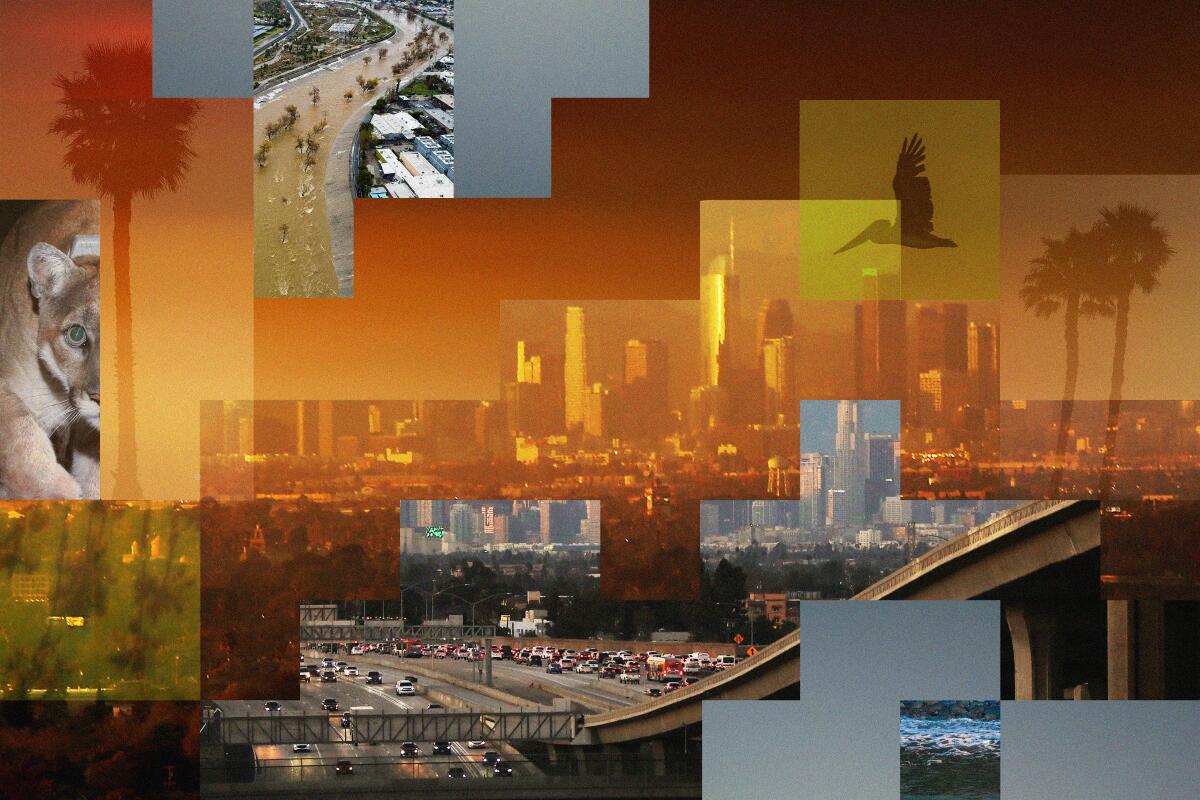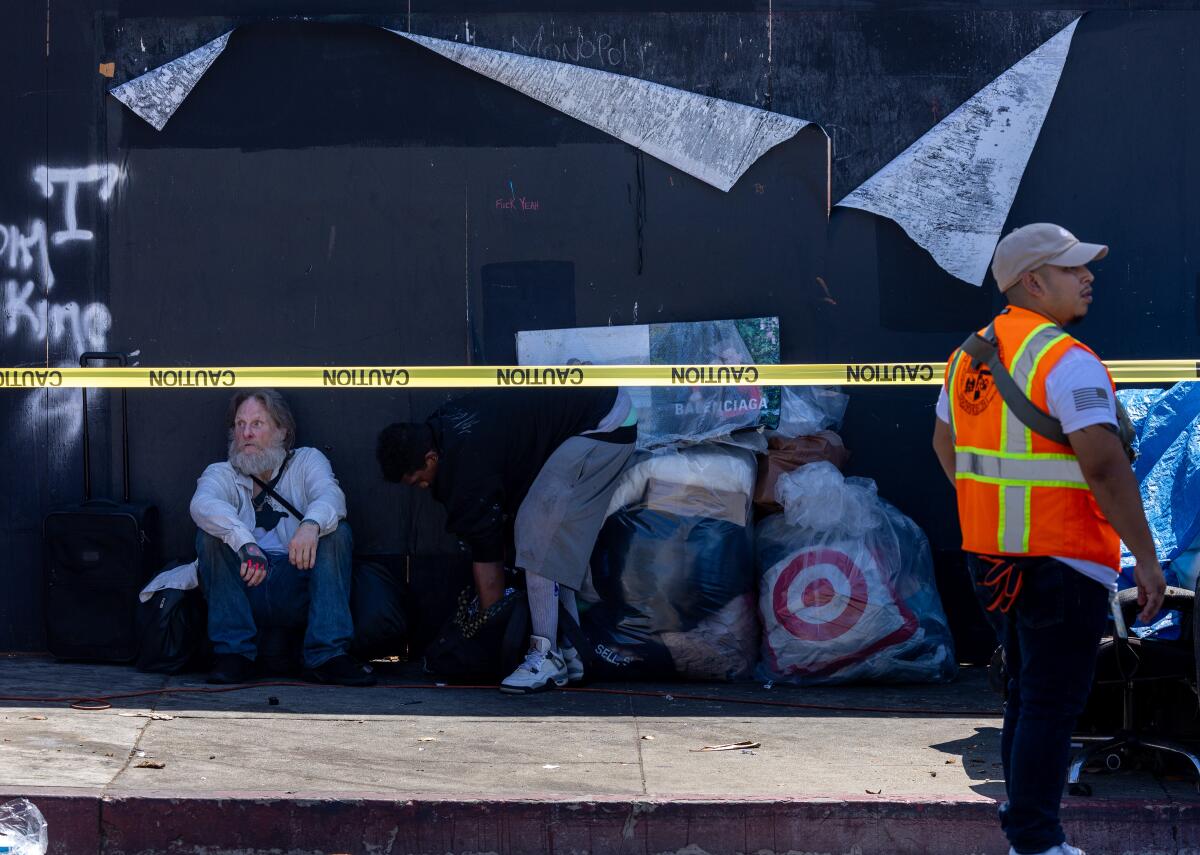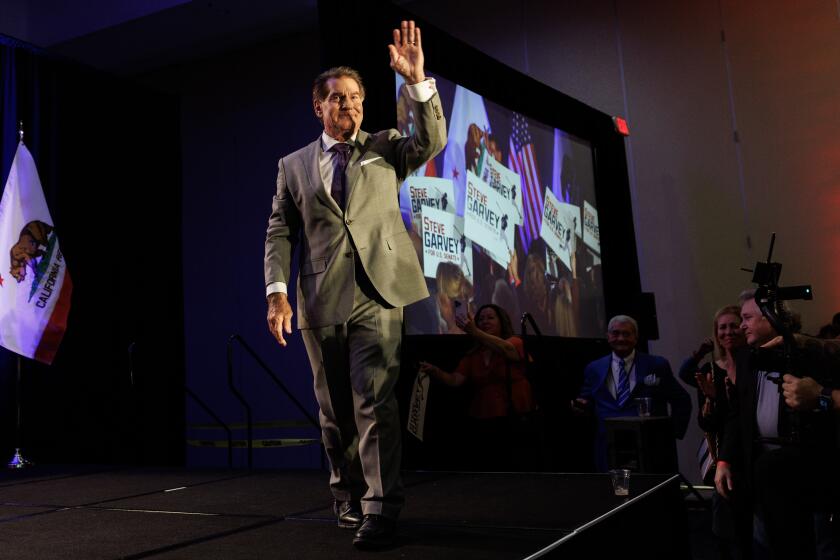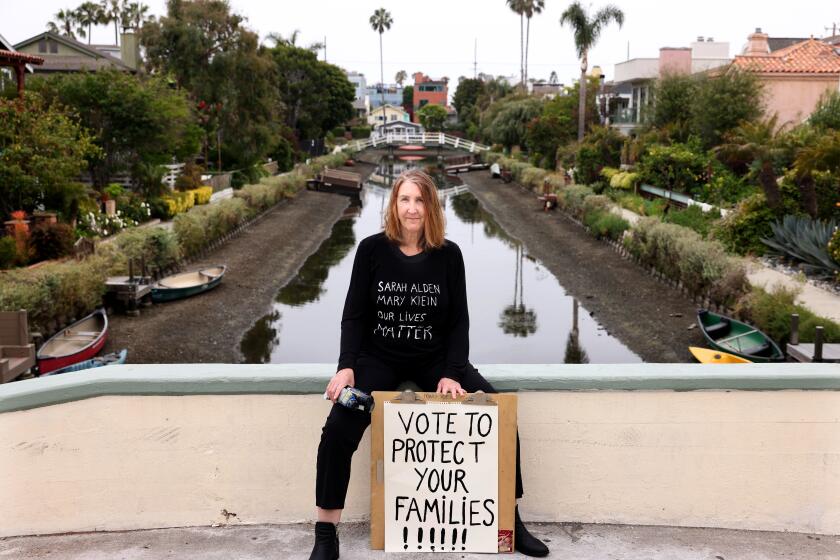Climate change is terrifying. These young people won’t give up fighting it.

Good morning. It’s Friday, Sept. 13. I’m Hayley Smith, a reporter on the climate desk. Here’s what you need to know to start your day.
- There is no escaping the damage we’ve done to our planet.
- Gov. Newsom signed another big retail theft bill.
- Here are 13 excellent Latin American restaurants to check out in L.A.
- And here’s today’s e-newspaper
Sign up for Essential California
The most important California stories and recommendations in your inbox every morning.
You may occasionally receive promotional content from the Los Angeles Times.
Earth is in peril. But these young people refuse to fall into despair.

Southern Californians emerged from a prolonged and punishing heat wave this week only to be greeted by a world on fire. Major blazes in Los Angeles, Orange, San Bernardino and Riverside counties are gnawing through sun-baked hillsides, threatening lives and properties and blanketing the region with noxious ash and smoke. (An earthquake on Thursday only ramped up the tension.)
The hellish conditions offer an all-too-real preview of a climate future dominated by more extreme temperatures and larger, faster and more frequent wildfires driven by fossil fuel emissions.
It’s no surprise, then, that young people are collectively concerned about what lies ahead. A recent Yale survey indicated that Gen Z and millennials are the most likely generations to be alarmed about global warming.
Their anxieties — and their commitment to solutions — inspired my colleagues to fan out across our beats to better understand how young people were grappling with climate change and extreme weather. One thing we heard over and over: People are anxious. After all, it’s hard not to feel existential dread at a moment when carbon dioxide levels in the atmosphere are soaring, global temperatures are breaking new records and climate hazards are touching more and more lives.
But young people are facing all of that while they’re also trying to plan their futures — when they’re thinking about where to go school, what cities to live in and whether to start families.
One way to address these fears, my colleague Rosanna Xia wrote in this powerful essay, is to focus less on individualism and more on the collective.
Our conversations with young people also revealed a number of other findings:
- For better or worse, social media is a near constant in their conversations about climate change. While there are millions of people posting about environmentally exploitative fast-fashion hauls on Instagram and TikTok, there are also scientists, experts and young people using the platforms to combat misinformation and spread optimism.
- Politics are top of mind. Some young people are approaching the climate challenge by working within the system, some are waiting for the system to change, and others are ready to burn the system down. We heard from youths who are finding hope in Kamala Harris, as well as kids who are suing the Environmental Protection Agency for violating their constitutional right to clean air and water.
- Climate change is on the curriculum. Teachers and students are incorporating the issue into their education, including green “forest schools” that are helping kids unglue from screens, and a board game that turns global warming into a learning opportunity.
- The kids aren’t fighting alone. While many will say that climate change is a “young person’s problem,” I spoke with a group of activists over the age of 60 who argue that it is, in fact, an “everyone problem.” The members of Third Act shared how they’re supporting young people on the front lines of the fight.
All that said, you don’t have to take our word for it. (After all, we’re old and grizzled reporters who have seen far too many climate disasters up close.)
We asked a dozen young people ages 7 to 26 to write their own essays on climate change, which will be published this Sunday. Here’s a sampling of what they wrote:
- Eighth-grader Abbott Swartz made a case for investing in nuclear fusion as a form of clean energy
- Simon Aron wrote about joining the Sunrise Movement at the end of middle school and later helping to organize a sit-in at JD Vance’s office
- Diana Michaelson, a college sophomore, described how she started a campaign for green schools in Long Beach and learned that patience is the key to success
- Calvin Hong, age 10, shared how he reduces waste by reusing pages from old notebooks to draw and solve math problems
“Once everybody takes part in reducing the effects of climate change,” Hong wrote, “it will help us to have a better future, with pleasant weather, less long-term drought, and less heat.”
Today’s top stories

It would cost $20.4 billion to end homelessness in Los Angeles in a decade, according to a city analysis
- A draft budget analysis from city housing officials calls for creating tens of thousands of new supportive and affordable housing units. It’s unclear when the analysis will be formally released to the public.
- There are about 45,000 people who are homeless in the city, 29,000 of whom are unsheltered, according to the most recent point-in-time count.
Gov. Gavin Newsom signed another retail theft bill amid rising concerns about crime in California
- The new law will add tougher penalties for individuals who take, damage or destroy property while committing any felony.
- The law is the last of 13 pieces of legislation at the center of a political saga at the state Capitol over how the state should address organized property crimes.
AI is better than humans at talking people out of their conspiracy theory beliefs, a study found
- An AI chatbot was able to persuade people to reconsider their beliefs in conspiracy theories about the JFK assassination, the moon landing and election fraud, according to a study published in the journal Science.
- The study provides insights into how to be more effective at combating conspiracy theories at a time when disinformation can quickly spread online.
More big stories
- A man tied to the killing of actor Johnny Wactor pleaded guilty to attempted robbery and theft.
- Ten L.A. schools could ditch standardized tests as early at next fall.
- Gascón and Hochman sparred in their first face-off of the L.A. County D.A. race.
- Rancho Palos Verdes, known for landslides, is home to Trump’s golf course.
- A huge deposit of marine fossils was found under San Pedro High School.
Get unlimited access to the Los Angeles Times. Subscribe here.
Commentary and opinions
- A terrible decision sparked a wildfire, and the public will pay the price, Karin Klein writes.
- Former Trump heavyweights need come forward publicly and warn voters that their former boss is unfit for a second term, columnist Jackie Calmes writes.
- The allure of Trump among California Republicans remains despite his depravity, columnist George Skelton writes.
- Think of Donald Trump as Robin Hood in reverse, writes Kimberly A. Clausing in a guest opinion.
- Without fanfare, parents like me are mourning our kids’ last first day of school, columnist Mary McNamara writes.
Today’s great read
The California sand wars: As beaches shrink, neighbors and cities fight for what’s left. Beaches are disappearing as sea levels rise and coastal development interferes with the replenishment of sand. Now one of the earth’s most common commodities is a precious resource to residents that cities spend millions of dollars on.
How can we make this newsletter more useful? Send comments to essentialcalifornia@latimes.com.
For your downtime

Going out
- 🌮 Here are 13 excellent Latin American restaurants to check out in L.A.
- 🕵️ A thrilling way to see Little Tokyo? Chase down a spy in this interactive mystery game.
- 🙊 The Hollywood remake of “Speak No Evil” swaps out Euro-bleakness for a family’s bonding, our critic writes.
- 🍿 Keanu Reeves, Sandra Bullock and Al Pacino lead an all-star lineup at Beyond Fest, which runs from Sept. 25 to Oct. 9.
- 🧟 “Beetlejuice Beetlejuice” highlights how studios are ramping up practical visual effects as audiences get more savvy about CGI.
Staying in
- 📺 Natasha Rothwell from “Insecure” and “The White Lotus” talks about how she confronted loneliness in “How to Die Alone,” which is out today on Hulu.
- 🇫🇷 ‘“Emily In Paris” gave Lucas Bravo his big break. He’s learning to embrace stardom.
- 📖 Cynicism has become an American epidemic — but there’s a cure, Stanford psychology professor Jamil Zaki explains in his new book “Hope for Cynics.”
- 🥗 Here’s a recipe for golden oat milk creme pies.
- ✏️ Get our free daily crossword puzzle, sudoku, word search and arcade games.
And finally ... a great photo
Show us your favorite place in California! Send us photos you have taken of spots in California that are special — natural or human-made — and tell us why they’re important to you.
Today’s great photo is from Enji Chung of Pasadena: the “otherworldly and sometimes haunting landscape” of Mono Lake.
Enji writes: “This photo was taken on a summer day, June 22, 2024. The conditions were perfect. The new moon created a very dark sky, and it was a very clear night. The Milky Way began rising behind the tufa formations, but this frame is when the galactic core of the Milky Way appeared.”
Have a great day, from the Essential California team
Ryan Fonseca, reporter
Defne Karabatur, fellow
Andrew Campa, Sunday reporter
Hunter Clauss, multiplatform editor
Christian Orozco, assistant editor
Stephanie Chavez, deputy metro editor
Karim Doumar, head of newsletters
Check our top stories, topics and the latest articles on latimes.com.
Sign up for Essential California
The most important California stories and recommendations in your inbox every morning.
You may occasionally receive promotional content from the Los Angeles Times.





